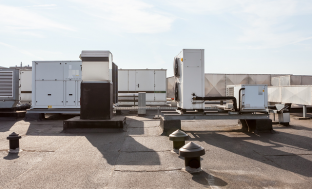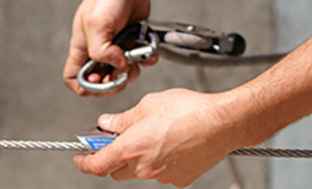latest news
Why recertification is vital: collective edge protection

Colin Pirrie, Business Development Manager, Roof Edge Fabrications
By law, companies are required to provide a safe working environment for their employees, which means that once a fall protection system has been installed it should be regularly maintained and serviced. This ensures it is safe to use at all times.
If an accident does occur and the equipment is found to be faulty and/or uncertified then you could be held accountable.
Regulation 5 of the Workplace (Health Safety and Welfare) Regulations, the Work at Height Regulations and BS EN 365 require all equipment to be maintained and inspected regularly by a competent person.
In these first part of a two part blog, we’re going to be taking a look at the importance of ensuring you have your collective fall protection systems inspected and recertified regularly.
Fall protection is vital for anyone working at height and you need to be sure the system you have is safe and will do its job. The only way to ensure this is by having it inspected and recertified by a competent and trained professional.
Each year we fail systems which just aren’t up to scratch and could put lives at risk. Below are a few examples:

#1 This guardrail system we failed in Cumbernauld is perhaps not obviously dangerous, but nonetheless very hazardous for anyone working on this roof.The guardrail was failed due to being improperly secured on the parapet that extends outwards from the roof. Though it may look perfectly suitable, any amount of weight put onto it could cause it to come away from the felt roof and cause serious injury, or worse.
This picture is a fantastic example of how even perfectly fine equipment can be dangerous when installed improperly. You should always make sure fall protection systems are installed by a competent person who understands their function and how they work.

#2 Another failed guardrail, but this time it should be obvious what the problem is. This guardrail in Livingston near Edinburgh isn’t going to do much to protect workers after years spent being battered by the elements.
This is no fault of the installer, but a good reminder that everything has a limited lifespan, and eventually will need to be replaced no matter how solid the product; however regular recertification will find problems like this before they cause serious harm.
Is it really that important?
You might think that guardrails and other collective edge protection may not need regular inspections as they’re not made of a number of moving components, so not much can go wrong, right?
Wrong. Although they are durable they still need to be inspected by a competent person as faults can, and do, occur. This is why we recommend that edge protection is recertified at least every 12 months.
These annual inspections should always be carried out by a competent person who can identify component or system faults as well as other issues.
Good to know: all manner of contractors and workers may need to access your roof and may all have different ideas of what safety is and the complexities of safety systems. We’ve seen cases where contractors have removed guardrails or added things to them, such as aerials. This type of activity can and does affect the integrity and effectiveness of the system.
What is looked at during recertification?
When a competent professional inspects a collective edge protection system they will usually look at the following:
Remember
- The original installation details to ensure the systems is as originally installed
- Signs of tampering or modification by other contractors
- Counterweights are all in the correct position, as detailed in the original layout drawing
- All base feet are in contact with the roof membrane
- All the grub screws are in place, greased and sufficiently torque
- The height and level of the system and the leg centres follow the manufacturer’s recommendations
- Any galvanised components which show signs of corrosion can be wire brushed and galvanised spray/paint applied if appropriate. Significant signs of rusting should be included in the report
- Where toe-boards are fitted, the brackets supporting the toe-board should be checked, greased and sufficiently torque
All types of fall protection are a vital part of keeping workers at height safe and you need to be confident that the system is safe and will do its job when necessary. The only way to do this is to make sure you regularly have the system inspected and recertified.
In part two of this blog, we’ll be taking a look other types of fall protection such as lifelines and anchors, and how through recertification you can ensure they will be effective when needed.
If you think your products are in need of inspection and recertification, drop us a line.





